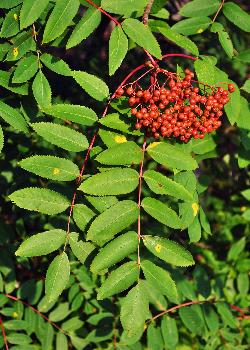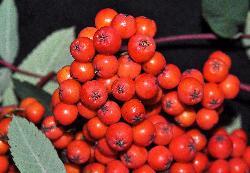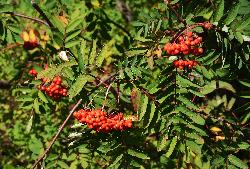Fr: sorbier plaisant, sorbier décoratif, sorbier de montagne
IA: mashkumin(an)akashi, mashkumin(an), tetamin
IU: kimminaujak (berry)
Rosaceae - Rose Family
Note: Numbers provided in square brackets in the text refer to the image presented above; image numbers are displayed to the lower left of each image.
General: A tall, open, deciduous shrub or small tree, 3–10 m tall, usually found in forest edges or gaps rather than in heavily shaded conifer stands [1–3]. Its broad clusters of many white flowers are followed by red-orange fruit that provide food to many species of birds. Sorbus decora var. groenlandica (C.K. Schneid.) G.N. Jones, previously recognized as a distinct species by some authors, is now included within the concept of Sorbus decora. Mountain ash fruits were traditionally used in Newfoundland to make dogberry wine, as well as jams or jellies, but the seeds should be discarded and the fruit cooked before eating. Warning: While not considered to be poisonous, all mountain ash species contain low levels of cyanogenic glycosides; the wilted foliage and seeds contain higher concentrations of this chemical and should not be consumed. When mashed or chewed, mountain ash seeds release hydrogen cyanide (HCN), a poisonous gas; however, ingestion of large quantities of seed is required to produce serious problems (Poulton 1983, Ebinger and Bergman 1987).
Key Features:
- Leaves alternate, pinnately compound, with 11–17 elliptic to oblong leaflets [4]. The leaflets have an acute to obtuse apex that often tapers to a short-acuminate point. The petiole and rachis are red and leaflets are roughly 2–3 times as long as wide.
- Numerous flowers are arranged in large flat-topped to domed inflorescences [5], to 16 cm across; individual flowers have 5 white petals, 15–20 stamens, and an inferior ovary partially fused to the hypanthium.
- Large clusters of red-orange to red fruit (pomes), 7–12 mm in diameter [6].
Stems/twigs: Main stems usually 1–4; the bark is grayish-brown and smooth; twigs are stout, glabrous, and grayish-brown to dark reddish-brown. Both terminal and alternate lateral buds are present; the terminal bud is conical, glutinous, and 1–2 cm long [7]. The scaly buds are large, lanceolate, dark reddish- brown or purplish-brown, sticky (glutinous), and often curved slightly at the tip. The bud scales are overlapping (imbricate); outer bud scales are glabrous, inner scales are ciliate along the scale margins, or hairy (villous) with short light brown to reddish-brown (rufous) hairs [8]. Leaf scars are narrow, broadly U- or V-shaped, and have 5 bundle trace scars [9].
Leaves: Alternate, pinnately compound, usually with 11–17 leaflets, and petiolate. The petiole, rachis, and often the midribs of the leaflets are reddish-green to deep red [4, 10]. Leaflets are elliptic, oblong, to lanceolate-oblong, sessile to short-stalked, and arranged in opposite pairs [10–11]. The terminal leaflet is elliptic to obovate, with a long stalk (petiolule) [12], the apex may be obtuse to acute. Lateral Leaflet are 3–8 cm long by 1.5–2.5 cm wide and 2–3.2 times as long as broad. Leaflet surfaces are bright green, bluish-green, or dark green and glabrous above, glaucous and glabrous to slightly pubescent beneath, with white villous hair along the midvein [13]. Leaflet bases are blunt, rounded, or slightly oblique, with the blade longer on the lower side of the midrib [14]. Leaflet apices may be obtuse to acute, and often narrow somewhat abruptly to a short-acuminate point. Margins are sharply serrate or double-serrate, especially on the leaves of younger plants [15–16]. Leaves turn yellow to red-orange or red in autumn [17–19].
Flowers: Bisexual, white, numerous (75–400+), in a terminal, branched, flat to dome-shaped inflorescence (compound cyme), 6–16 cm across [20–21]; the branches and pedicels are pubescent with villous hairs. Flowers are 8–12 mm across and have a short-pubescent hypanthium with 5 triangular calyx lobes, 1.5–1.8 mm long, that have glandular-serrulate margins. Attached to the rim of the hypanthium are 5 orbicular to obovate short-clawed white petals, 3.5–5 mm long, and 15–20+ stamens, which have white filaments and creamy-white anthers. The pistil has an inferior ovary of 2–5 carpels, partially adnate to the hypanthium, and 3–4 styles, 1.5–2.5 mm long, each ending in a small capitate stigma [22]. The scent of dogberry flowers is often described as a disagreeable odour. Flowers bloom in late spring to mid-summer (June–July), and pollination is carried out by a variety of insect species (entomophily).
Fruit: A cluster of red-orange to red berry-like fruit (pomes) [23–24]; individual pomes are globose to slightly depressed-globose, up to 9 mm long by 7–12 mm across [25]; mature fruiting stalks (pedicels) are reddish; the calyx lobes become incurved in fruit, with the tips folding over the top of the fruit. The flesh of the pomes is yellow-orange and bitter; mature brown seeds are 4.5–5 mm long by 1.5–2 mm wide. Fruits mature in late summer to early autumn (August–September), but remain on the branches throughout winter. Dispersal is by frugivorous birds, particularly waxwings and grosbeaks, which consume the fruit and regurgitate or defecate the seeds (endozoochory). During years of good weather, when pollinators are able to successfully cross-pollinate the flowers, large fruit crops often develop, sometimes causing branches to droop or even break under the weight of the numerous fruits [26–27].
Ecology and Habitat: Showy mountain ash primarily occurs on moist to wet, medium to nutrient-rich forest soils, and has an ecology similar to that of American mountain ash (Sorbus americana). Although shade-tolerant, it appears to be more abundant in the early rather than later successional stages of coniferous forest succession. It can readily regenerate from root sprouts following moose browsing or low intensity fires.
Edaphic Grid: See image [28]: the Edaphic Grid for Sorbus decora.
Forest Types: Showy mountain ash has been recorded from the following forest types:
- Abietum dryopteretosum (Dryopteris-Balsam Fir Forest Subassociation)
- Abietum gaultherietosum (Gaultheria-Balsam Fir Forest Subassociation)
- Abietum rubetosum (Rubus-Balsam Fir Forest Subassociation)
- Abietum taxetosum (Taxus-Balsam Fir Forest Subassociation)
- Kalmio-Piceetum taxetosum (Taxus-Kalmia-Black Spruce Forest Subassociation)
Foster (1984) recorded showy mountain ash in his Birch Forest, Fir-Spruce Feathermoss Forest, Spruce-Pleurozium Forest, and Spruce-Fir Forest communities in southeast Labrador. Wilton (1965) describes showy mountain ash as a frequent but low abundance species in his Fir-Spruce-Birch/Rich Herb Forest type.
Succession: The successional status of showy mountain ash is poorly understood. Based on general observations, it appears to behave similar to the closely related American mountain ash in that it is generally less abundant in mature stages of stand development than early succession after cutting and fire.
Distribution: Showy mountain-ash is native to boreal northeastern North America; its range extends from Newfoundland and Labrador west to Saskatchewan. In Newfoundland, it commonly occurs from the northern Avalon Peninsula across the Island to western Newfoundland, but has not been reported from southwest or south coastal regions (Rouleau and Lamoureux 1992); in Labrador, it occurs north to about 56° N, northwest of Makkovik (Day 1999). In the United States, showy mountain ash is restricted to New England and border States along the Great Lakes, extending west to Minnesota. Within these States, it occurs most commonly in Maine, New Hampshire, the Upper Michigan Peninsula, and northern Minnesota (USDA, NRCS 2016).
Similar Species: American mountain ash (Sorbus americana Marshall), is similar to showy mountain ash, but has longer narrower leaflets that taper gradually to an acuminate apex, and smaller pomes, each 4–7 mm in diameter. The leaflets of mature American mountain ash leaves are 3.5–5 times longer than wide, compared to 2–3.2 times longer than wide in leaflets of showy mountain ash. The flowers of American mountain ash bloom about 1 week earlier than those of showy mountain ash.
In urban areas, the European mountain ash (Sorbus aucuparia L.), also known as dogberry or rowan tree, is frequently planted and may spread to adjacent natural areas by frugivorous birds. European mountain ash can be distinguished by its buds, which are non-glutinous and covered with white tomentose hairs, its more pubescent young branches, the more densely pubescent lower surface of its leaflets, and its more golden-orange pomes (6–9 mm across), although fruit colour varies with different cultivars.
Red elderberry (Sambucus racemosa L. subsp. pubens (Michx.) S.Watson) has pinnately compound leaves and large white-flowered inflorescences similar to those of mountain ash species, but the leaves of red elderberry have only 5–7 leaflets and the white flowers are arranged in an elongate or pyramid-shaped inflorescence. The flowers of red elderberry have an inconspicuously toothed green calyx, a white corolla with 5 rounded lobes, only 5 stamens, and a pistil with an inferior ovary; fruits are small iridescent red berry-like drupes 4–6 mm long.



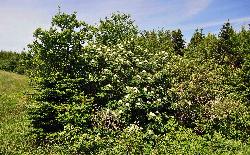
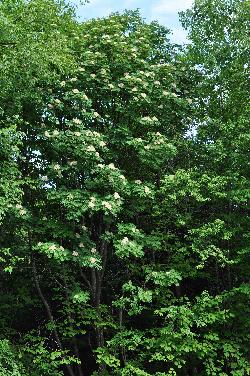
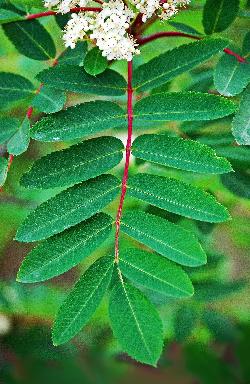
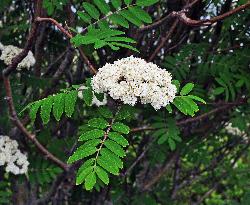
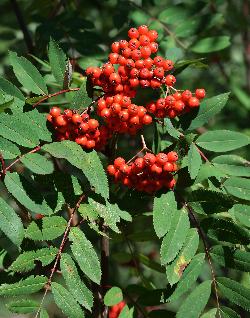
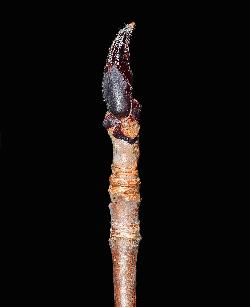
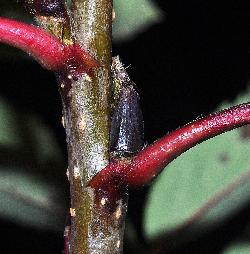
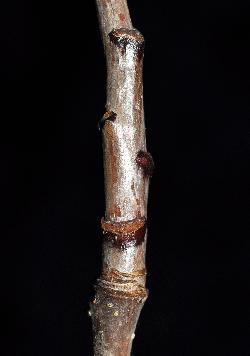
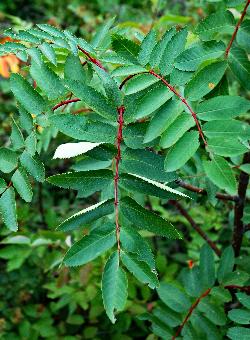


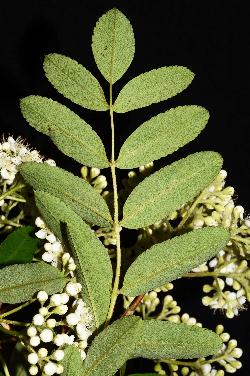
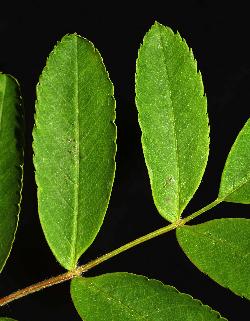
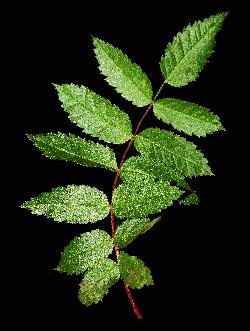

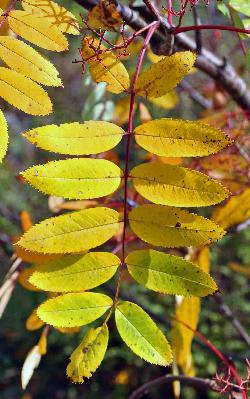
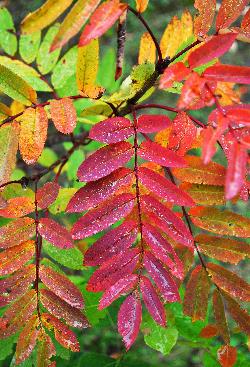
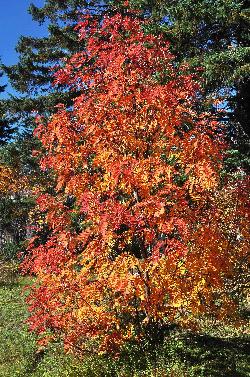
Sorbus_decora_sjm1964_Jun22-08_17_12_2018_2_33_57.jpg)


